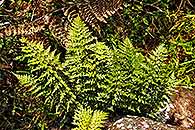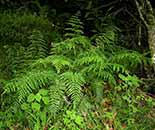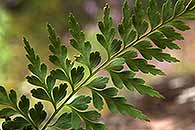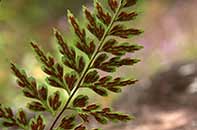Asplenium aethiopicum (Burm. f.) Bech. [aggregate]
Synonyms |
Asplenium adiantoides Lam. |
|---|---|
Common name |
|
Description |
Rhizome shortly creeping or ascending, up to 7 mm thick. Rhizome scales 3-7 x 0.3-0.6 mm, linear to narrowly triangular in outline, apex tapering to a point, dark brown to blackish, entire or with a few hair-like outgrowths, ending in hair-point. Fronds tufted to shortly spaced, not proliferous. Stipe 4-40 cm long, dark brown to blackish, covered with hair-like scales when young, subglabrous with age except near the base. Lamina very variable in size, shape and degree of dissection, 8-64 cm × 2.5-27 cm, strongly 2-pinnatifid to 3-pinnate, ovate to narrowly lanceolate in outline with the basal pair or 2 of pinnae occasionaly reduced in size. Pinnae ovate to narrowly lanceolate in outline, apex acute, sometimes drawn out into a thin, narrow terminal segment, base unequally cuneate, margins irregularly toothed. Pinnules upper surface subglabrous, lower surface sparsely set with twisted scales. Sori linear, 2.5-14 mm long, set along flabellate veins, sori more than one per lobe, indusium narrowly linear, membraneous, subentire, 0.3-0.5 mm wide. |
Notes | The extreme variability of this species makes it difficult to distinguish it from others in this group. A. aethiopicum has recently been split up in 4 subsp.(J.P.Roux,2001). We have lumped these for the time being. These subspecies usually grade from one to the other and are hard to distinguish without a strong microscope to examen the spores. |
Derivation | aethiopicum: of Ethiopia, a historic name for large parts of Africa |
Habitat | Wide variety of habitats, deciduous woodland, high altitude mist forest, riverine forest, evergreen coastal forest. Terrestrial, epiphytic or lithophytic. |
Distribution worldwide | Throughout tropical Africa and to South Africa, Comoro islands, Mauritius, Madagascar. |
Distribution in Africa |
Angola, Burundi, Cameroon, Central African Republic, Chad, Congo, Dem. Republic of Congo, Djibouti, Equatorial Guinea (incl. Bioko), Eritrea, Ethiopia, Gabon, Guinea, Kenya, Lesotho, Liberia, Malawi, Mozambique, Nigeria, Rwanda, Sierra Leone, Somalia, South Africa, Sudan and South Sudan, Swaziland, Tanzania , Uganda, Zambia, Zimbabwe. |
Growth form |
Epiphytic, lithophytic, terrestrial. |
Literature |
|





